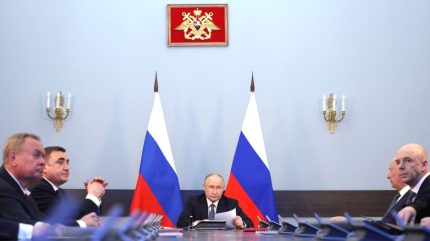
Russia’s President Vladimir Putin has outlined a long-term development strategy for the Navy, aiming to enhance its capabilities by 2050.
During a strategic meeting in St Petersburg, Putin unveiled the financial commitment of Rbs8.4trn ($100.88bn) earmarked for constructing new naval vessels over the coming decade, according to the Kremlin.
This budget allocation is to be factored into the state armament programme, with emphasis placed on aligning these funds with the Navy’s developmental plan.
Putin emphasised the need for a realistic evaluation of Russia’s capabilities within its shipbuilding sector and associated industries, stressing that all prior directives, including those from a shipbuilding-focused meeting on 26 June 2024, must be executed fully.
The meeting also addressed cost considerations in shipbuilding and fostering advancements in Russian-made components and equipment.
A key aspect for enhancing the Navy’s operational capacity is the advancement and mass production of indigenous maritime uncrewed aerial vehicles and robotic systems, as well as uncrewed underwater and surface vessels, he said.
Furthermore, it was noted that such systems—whether airborne, subaquatic or surface-based—should be seamlessly integrated into a unified reconnaissance and strike network that operates in synergy with Russia’s satellite assets.
In the last five years, Russia has constructed 49 ships of various classes.
From 2020 to 2024, the Navy has already welcomed four Project Borei-A strategic submarines and four Project Yasen-M multipurpose submarines into service.
Putin said: “I would like to note that we are always paying close attention to the improvement of our Navy. As you know, recently, in late March, we launched a new multipurpose submarine Perm in Severodvinsk.
“We also discussed many important issues pertaining to the development of our fleets, social assistance to sailors and their families, and the modernisation of our naval bases and infrastructure of military settlements, which is especially important for our Arctic territories.”
The Perm submarine has been recognised as the inaugural vessel to be equipped with Zircon hypersonic cruise missiles.
When queried about the range of the Zircon missile system, Navy commander-in-chief Alexander Moiseyev informed that it exceeds 1,000km.
President Putin added that the missile’s speed approaches Mach 10, classifying it as a strategic asset capable of executing high-level missions.
He also said that the government’s objective is to bolster the domestic fleet, particularly its strategic nuclear forces segment.
Putin highlighted that the modernisation of Russia’s maritime strategic nuclear forces is complete, with a 100% modern armament and equipment rate.
He underscored the necessity to continue and amplify the serial production of modern vessels across different classes.
These are expected to be outfitted with technology such as high-precision and hypersonic weapons, robotic systems, and advanced control, reconnaissance, communication, radar, hydroacoustic, and more.
He further added: “At the same time, it is evident that the dynamics of the changing global situation, the emergence of new challenges and threats, including those in maritime domains, as well as the vigorous technological and digital revolution, robotisation, and the widespread implementation of unmanned systems – all these necessitate the formation of a new profile for the Navy.
“In this regard, it is crucial to define the prospective characteristics and balanced composition of the fleet, while assessing the capabilities of scientific and industrial potential in designing and constructing new warships and support vessels. In this context, I consider it imperative to emphasise the importance of systematically and consistently developing all components of the Navy, including submarine and surface ship groups, naval aviation, coastal missile and artillery troops, as well as support systems.”
Furthermore, Putin stated that these systems, whether operating in the air, underwater, or on the surface, must be seamlessly integrated into a unified reconnaissance and strike network, connected to Russia’s satellite constellation.


